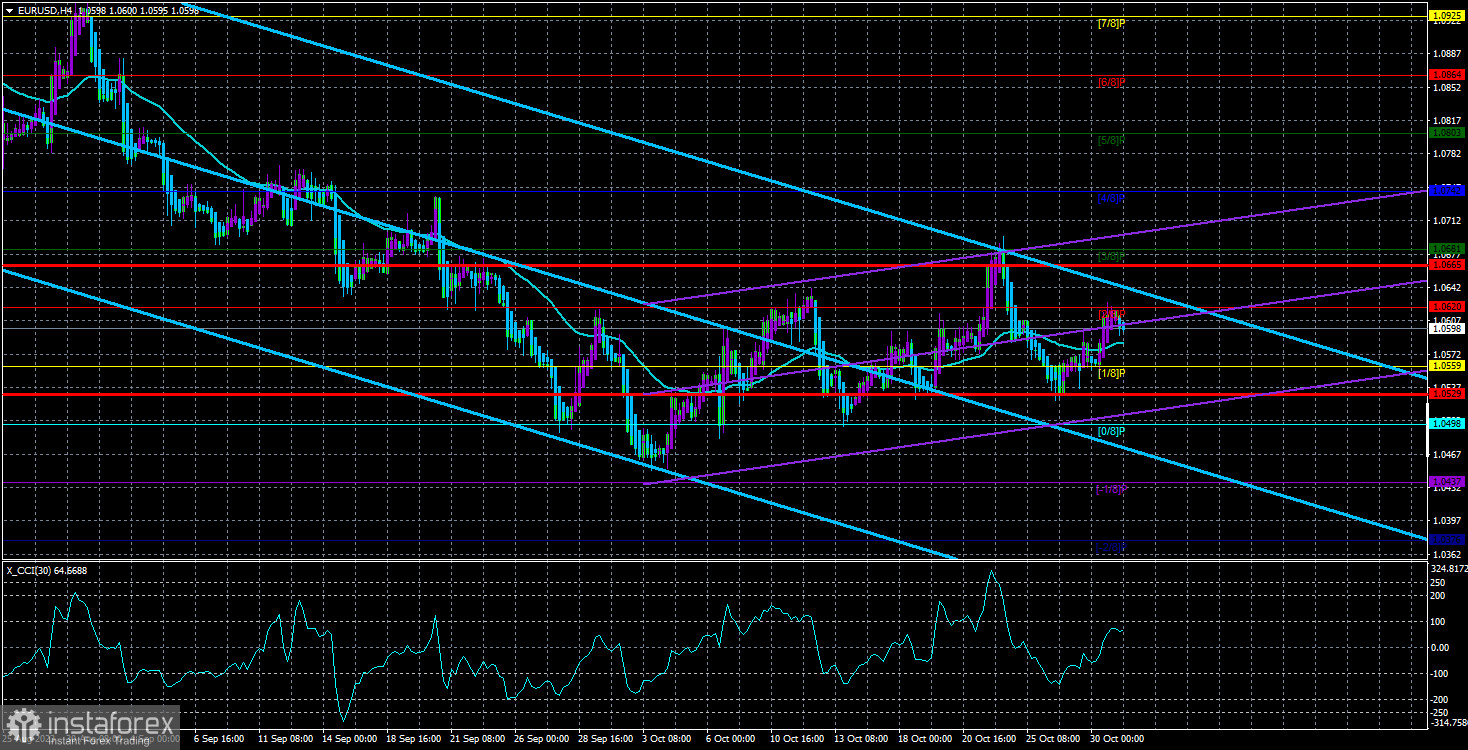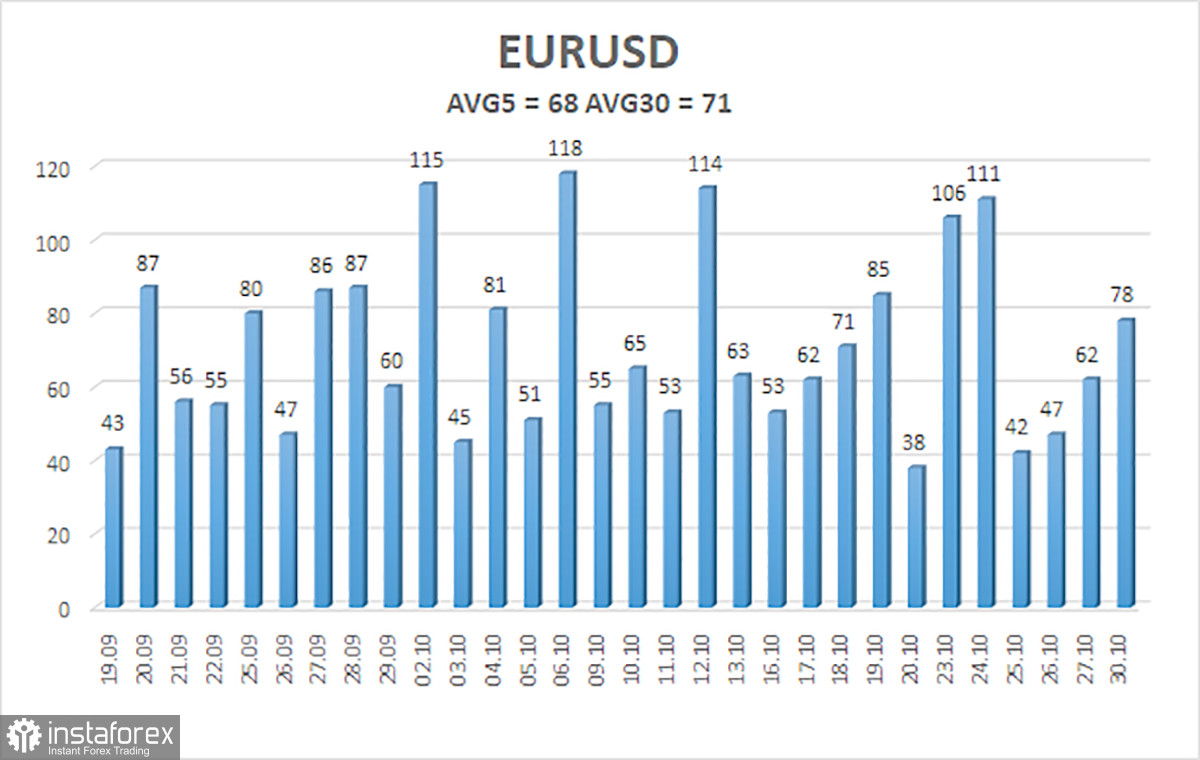
The currency pair EUR/USD started the week with renewed strength on Monday. This statement would be accurate if the volatility did not once again show a rather average value and the price hadn't been fluctuating for several weeks. We have repeatedly mentioned recently that we are expecting a stronger correction from the European currency, and eventually, it did show a more or less decent correction loop, after which it had every reason to resume the downward trend. However, the last few days suggest that there might be another correction loop. The euro is struggling to move upward with great difficulty. It is clear to the naked eye that it is having a hard time growing. Therefore, we believe that the decline will resume in any case, whether it involves another correction loop or two.
Anything can happen this week. Meetings of the Bank of England, the Federal Reserve, labor market reports, unemployment data, and business activity in the US. All this data can move the euro up or down by 150–200 points. However, what matters here is the overall fundamental background that acts on the pair in the background. In other words, if we only receive "dovish" rhetoric from the ECB about their reluctance and impracticality of raising rates, how should the euro react? If we repeatedly receive disappointing reports from the European Union, how should the euro react? If most of the information from the United States is positive for the dollar, how should the euro react?
These are all rhetorical questions, so we have no doubt that the decline in quotes will resume. Today, data on GDP for the third quarter and inflation for October will be published in the European Union. Similar reports were released in Germany yesterday and were stronger than expected. Inflation in the EU may slow down to 3.1%, so the European currency may rise a bit today. After all, a decline in inflation is good, but the ECB's refusal to further tighten is bad, especially since the Fed has not yet completed its rate hike cycle.
ECB representatives continue to spout "dovish" rhetoric. Let's be honest: if inflation in the EU slows down to 3.1% today, it will be a great result for the ECB. It will achieve almost the same progress in fighting inflation as the Fed, but with a 100-point rate increase less than the American regulator. This is despite the fact that initial inflation in the EU was much higher than in the US. Therefore, there are reasons for the European currency to be joyful. However, the American economy is stronger, and the Fed may raise the rate once more (especially due to the rising inflation in recent months), while we have been hearing only "dovish" statements from the ECB lately.
Just yesterday, two members of the ECB's Monetary Policy Committee, Peter Kazimir and Boris Vujcic, stated that the rate hike cycle is over. They, of course, allowed for a rate hike "retrospectively," "if the situation requires it," but that's not the point. It is clear that a drop in inflation to almost 3% puts into question the need to continue raising the rate. However, following the example of the United States, it can be concluded that inflation could still accelerate. In any case, why speculate about the future? If the consumer price index starts rising again, then we'll need to ask the ECB questions about the need to raise the rate a little more.
For now, the euro may receive only local support, but in the long term, it will likely continue to decline. A rebound today from the Murray level of "2/8" at 1.0620 may lead to the formation of a "head and shoulders" pattern, which will further increase the likelihood of a new drop in the pair. In the 24-hour timeframe, the price continues to hover around the critical line and the Fibonacci level of 38.2%.

The average volatility of the EUR/USD currency pair for the last 5 trading days as of October 31st is 68 points and is characterized as "average." Thus, we expect movement in the pair between the levels of 1.0529 and 1.0665 on Tuesday. A reversal of the Heiken Ashi indicator upward will indicate the possibility of a resumption of the downward movement.
Nearest support levels:
S1 - 1.0559
S2 - 1.0498
S3 - 1.0437
Nearest resistance levels:
R1 - 1.0620
R2 - 1.0681
R3 - 1.0742
Trading recommendations:
The EUR/USD pair continues to change its direction almost every day. Therefore, relying on moving averages is a challenging task at the moment. If the level of 1.0620 is surpassed today, the pair may grow by another 50–60 points. It is very difficult to predict what will happen in the second half of the week.
Explanations for the illustrations:
Linear regression channels - help determine the current trend. If both are pointing in the same direction, it means the trend is currently strong.
Moving average line (settings 20.0, smoothed) - determines the short-term trend and the direction in which trading should be conducted.
Murray levels - target levels for movements and corrections.
Volatility levels (red lines) - the probable price channel in which the pair will trade over the next day, based on current volatility indicators.
CCI indicator - its entry into the oversold area (below -250) or overbought area (above +250) indicates that a trend reversal in the opposite direction is approaching.





















